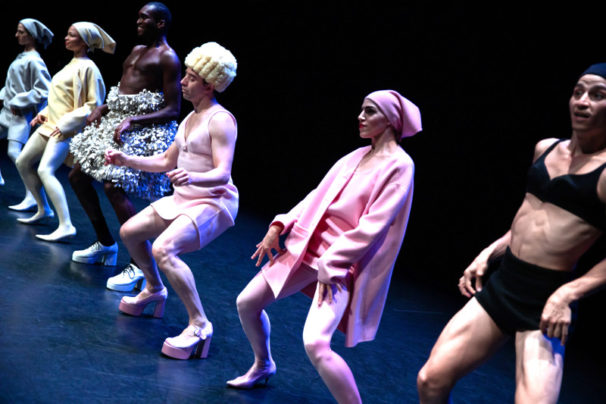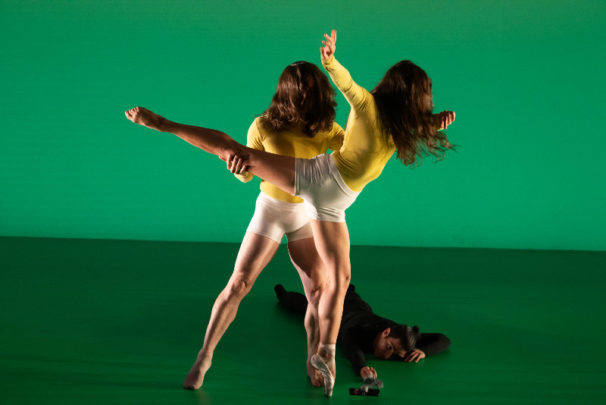
There they were, two luminaries of the 1980s NYC dance scene, facing us 40 years later, Karole Armitage and Jock Soto, in simple black and grey outfits. Armitage got everyone’s attention with Drastic Classicism (1981), a fierce, high-gloss, visually and sonically arresting work that shook up ballet conventions with outrageous costuming and ear-shattering sound by Rhys Chatham. Soto, who emerged in the era as an important member of New York City Ballet while still in his teens, became a principal dancer, highly admired partner, and performer of choice for the company’s guest choreographers.
For Armitage, A Pandemic Notebook was a return to the venue where Drastic Classicism had its premiere: then called Dance Theater Workshop, it’s now New York Live Arts. That piece earned Armitage the “punk ballerina” moniker that endured even after she’d moved on to very different explorations. (Ballet trained, she danced with the Geneva Ballet before her stellar five-year stint with Merce Cunningham’s company, 1976-81.)
The two dancers connected in recent years, and in 2020 Armitage created a 25-minute film, Time/Times, with Soto shot in scenic Colorado and New Mexico settings. As the centerpiece of this week’s 75-minute A Pandemic Notebook, they performed excerpts from that film, which Armitage describes as (what’s known as) “slow cinema.”
Soto appeared first, powerful and grounded, he moved assertively through weighted gestures. With his hair in a top-knot and his gaze focused, he could have been a Samurai warrior in a preparatory ritual. Armitage then took the opposite side of the stage, masked. and with her hair also in a top-knot. Slender and quietly elegant, she moved fluently and with a few nods to ballet – at one point she did bourrées in her black socks.
Once they came together, she seemed to adopt his weighted clarity and he her grace, as they glided into unison and shaped each position – a lifted bent leg, suspended before being placed back down – with clarity and deliberation. Projected behind them, a series of stunning natural settings evoked a sense of limitless vastness.
Allusions to, and evocations of, film was the over-arching theme of A Pandemic Notebook. Film – occasional montages – was a constant presence behind the performers, and also offered elegant continuity to a program that unfolded as a continuous event, with barely a pause.

In the opening Beautiful Monster, a haughty, androgynous duo (Sierra French and Alonso Guzman) – in gleaming long tunics, styish turban headpieces and heels – glided through private, mysterious activity until a very odd dark intruder slithered on from upstage and literally came between them. More creature than human, wearing black trunks and a scuba mask, Cristian Laverde-Koenig lured French away from her stylish hauteur as she stripped down to a shiny leotard and vamped teasingly on a chair. The piece was intriguingly obtuse; maybe one needed familiarity with the Visconti film, The Witch Buried Alive, that inspired it.

Two of Armitage’s own short films were certainly eye-catching and rather disorienting, in an enjoyable way. (They are from her series titled Under the Dancer.) Killer, with nerve-jangling music by David Lang, presented a triptych of trippy scenarios with dancers’ bodies appearing like giant attacking insects within red rectangular framed spaces. As bodies careened in and out of the three settings, it was hard to glean what was going on. It was vivid and eerie – but its intense red palette was one of the few bursts of color in an evening of mostly pale or black designs.

Andy was less disorienting; as two dancers in practice clothes unfolded through close partnering while being filmed from what seemed impossible angles, often from below. A short live follow-up, Andy “Making Of”, with Armitage (still masked) “directing” the same pair (French and Laverde-Koenig) through segments of the duet as Guzman contorted himself around and beneath them with a camera, was less than illuminating.
The program included several other brief, somewhat impenetrable works in which style and veneer, rather than movement, got emphasis. The dancers were vivid and committed, and the overall presentation was smartly conceived so that the “action,” so to speak, proceeded smoothly. But little of it had the focused intensity and purity of purpose that marked the barely ten minutes we spent with the most wonderful aces of eighties dance, Armitage and Soto, dance warriors.
Susan Reiter covers dance for TDF Stages and contributes regularly to the Los Angeles Times, Playbill, Dance Australia and other publications.
Karole Armitage | A Pandemic Notebook | New York Live Arts | Mar 16-19
